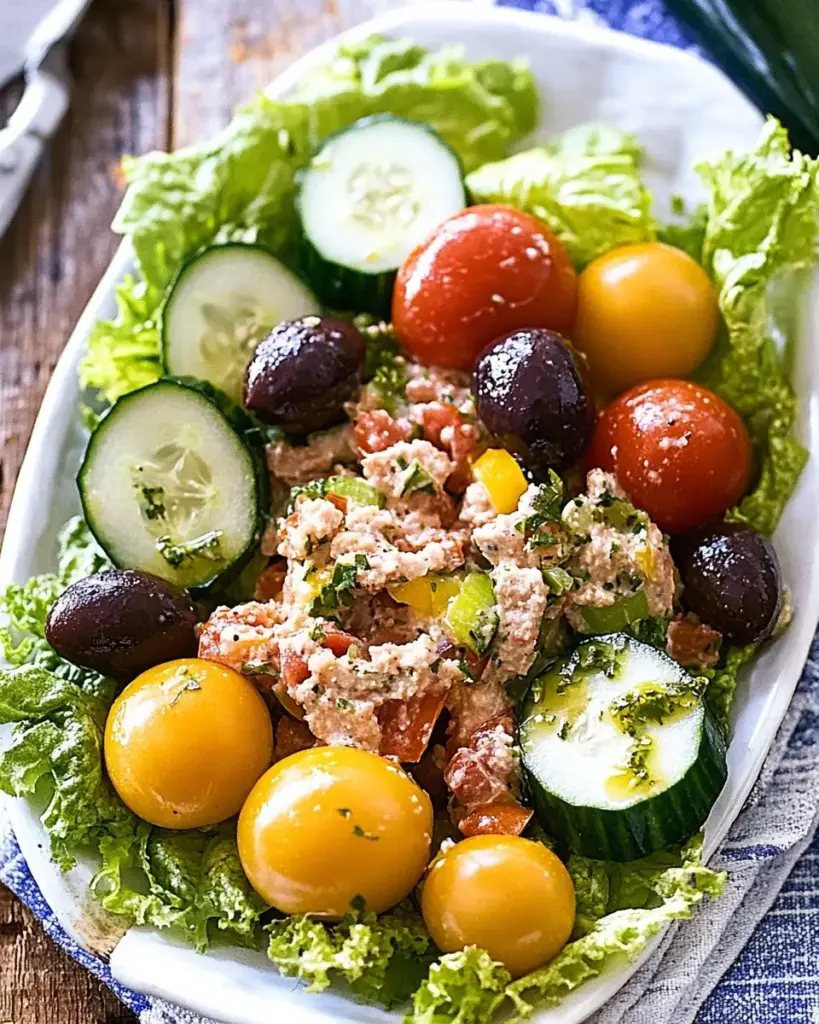A Memory Woven in Olive Oil and Sunlight
Every year on May 15th, the streets of Madrid burst into color. The scent of roasted chestnuts mingles with laughter and music, and families gather beneath the spring sun to honor San Isidro Labrador, the patron saint of the Spanish capital. For many Madrileños, the day begins not in cathedrals but around the family table. And at the center of that table sits something deceptively simple, yet utterly sacred: Ensalada de San Isidro.
I remember the first time I tasted this salad. I was ten, sitting cross-legged on my abuela’s tiled kitchen floor as she carefully halved cherry tomatoes with hands weathered by decades of devotion. She didn’t use a measuring spoon for the olive oil—she simply knew. With every drizzle and stir, I could feel history pass from her fingers into the bowl.
That moment, fragrant with garlic and green olives, became a memory I carry everywhere. And every time I make Ensalada de San Isidro now, whether on a rooftop in Barcelona or in a tiny New York apartment, it brings me home.
But this isn’t just my story. This is Madrid’s story.
The Heartbeat of a Festival: Origins of the Ensalada
Ensalada de San Isidro is more than a dish—it’s a tribute. The salad is traditionally served during the Fiestas de San Isidro, which celebrates Isidore the Laborer, a 12th-century farmworker canonized for his humility and devotion to the land. Legend tells of miraculous springs he brought forth and angels plowing his fields so he could pray longer. What better way to honor such a man than with a dish born of the earth’s simplest gifts?
This salad, humble and bright, was never meant to impress with extravagance. It was meant to celebrate abundance through simplicity. Built on crisp lettuce, salty tuna, boiled eggs, olives, and a quick vinaigrette, it speaks of rural kitchens and hardworking hands. It’s a reminder that sometimes, the most memorable meals are the ones that stay closest to their roots.
The Ingredients as Storytellers
Each element in Ensalada de San Isidro has a purpose, not just for flavor, but for the story it tells.
Lettuce: The Crunch of Fresh Beginnings
Romaine is the classic choice, known for its structure and clean, grassy bite. In a symbolic sense, it represents new growth—fitting for a springtime festival. The lettuce serves as a fresh canvas, the base that lifts the rest of the ingredients into harmony.
Tuna: The Soul of the Sea
Canned tuna in olive oil adds richness and depth. This wasn’t always accessible, and in the past, preserved fish was a luxury for special occasions. It connects landlocked Madrid to the Spanish coasts, a culinary bridge between regions.
Olives: A Nod to Spain’s Ancient Groves
Green and black olives offer brine and balance, representing both the history and diversity of Spanish agriculture. These trees, some centuries old, are the silent witnesses to countless family meals.
Eggs: Nourishment and Celebration
The hard-boiled egg is more than protein—it’s a symbol of life. Sliced and laid over the salad, it evokes the sun in its yolk, a quiet nod to fertility and growth.
Tomatoes and Onions: Sweetness Meets Bite
Cherry tomatoes and red onions offer contrast—sweet, acidic, crisp, and punchy. These are not just add-ons; they are the conversation between flavors.
Vinaigrette: A Whisper from the Earth
Garlic, parsley, olive oil, and sherry vinegar—this simple dressing ties everything together. The vinegar adds zing, the parsley freshness, and the garlic an earthy richness. It’s a rural flavor handed down from generation to generation.
More Than a Side: How and When to Serve It
While Ensalada de San Isidro is often served as part of a festive spread during the feast day, it’s incredibly versatile. Here’s how it shines across settings:
- As a Main Dish: Pair it with crusty bread and a glass of white wine, or a cold Spanish beer like Mahou. The tuna and eggs make it hearty enough to stand alone.
- Alongside Grilled Fish or Roasted Potatoes: The salad’s freshness cuts through richer dishes, adding brightness to the plate.
- In Tapas Style: Serve it in small portions alongside manchego cheese, jamón, and marinated anchovies for an authentic tapas experience.
- In a Picnic Basket: Because it holds up well even after dressing, it’s a fantastic option for outdoor gatherings or summer lunches.

Frequently Asked Questions: Everything You Didn’t Know You Needed to Know
Can I make it ahead of time?
Yes, but with one caveat: keep the vinaigrette separate until just before serving to prevent sogginess. You can prepare all the components a few hours in advance and store them in the fridge.
What if I don’t like tuna?
Try swapping it with grilled sardines, anchovies, or even roasted chickpeas for a vegetarian twist. Vegan versions with jackfruit or marinated artichokes are also delicious.
I’m not a fan of romaine. What can I use instead?
Little Gem, butter lettuce, or even baby spinach can substitute beautifully. The key is crunch and freshness.
How traditional is this version?
The ingredients and preparation mirror what you’d find on a Madrileño family table. That said, there’s room for personalization. Some families add roasted red peppers, capers, or even boiled potatoes.
Is it kid-friendly?
Absolutely. The mild, familiar ingredients make it a great way to introduce kids to Mediterranean flavors. Just chop everything a bit smaller for easier eating.
What wine pairs best?
A dry Spanish white like Albariño or Verdejo works beautifully. For red lovers, go for a young Rioja—fruity, not too tannic.
The Magic in the Ordinary
What’s remarkable about Ensalada de San Isidro isn’t just how good it tastes. It’s how it connects us—to the land, to tradition, and to each other.
In a world that sometimes moves too fast, this salad invites us to slow down. To slice tomatoes with care. To whisk vinaigrette with purpose. To share stories while peeling eggs. It is not only a dish of celebration but of presence—a practice in remembering that the best meals are made with time, intention, and love.
I still make this salad every May, even if I’m miles away from Madrid. I eat it with friends who’ve never heard of San Isidro, and by the end of the meal, they’ve come to know him in their own way—through flavor, through laughter, through the quiet joy of sharing something simple and beautiful.
Advertisement
Conclusion: A Plate Full of Heritage
Ensalada de San Isidro is proof that the most unforgettable flavors are often born from the humblest of ingredients. Rooted in Spain’s history, shaped by its people, and carried through time in the hands of home cooks, this salad is a culinary postcard from Madrid’s heart.
Whether you serve it during the festival or on an ordinary Tuesday, know that you’re making more than a salad. You’re reviving a tradition, honoring a saint, and—perhaps most importantly—creating a memory that just might become someone else’s origin story.
So the next time you’re looking for a dish that’s more than the sum of its parts, reach for Ensalada de San Isidro. And may your kitchen, like mine, always carry the warm echo of old family stories and fresh spring parsley.

Spanish Tomato Cucumber Salad is a must-try dish!
Ingredients
Method
- In a small bowl, whisk together olive oil and sherry vinegar. Grate in the garlic, stir in chopped parsley, and season with sea salt and black pepper. Whisk until well emulsified. Set the dressing aside.
- Prepare the romaine lettuce by removing the leaves, rolling them together, slicing horizontally in half, and then cutting into 1-inch vertical strips. Rinse and thoroughly dry using a salad spinner or clean cloth. Transfer to a large salad bowl.
- Layer the red onion slices and cherry tomato halves over the lettuce. Evenly distribute the drained tuna across the salad.
- Add both green and black olives on top. Arrange the halved hard-boiled eggs around the salad for garnish.
- Lightly season with extra salt and pepper, then drizzle the prepared vinaigrette over the salad. Serve immediately for best flavor and texture.
Notes
Sherry vinegar offers a unique tang—substitute with red wine vinegar if needed.
For added texture, consider topping with toasted almonds or crusty bread on the side.






